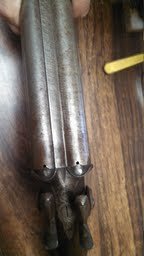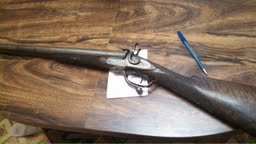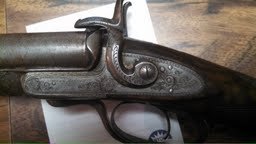You are using an out of date browser. It may not display this or other websites correctly.
You should upgrade or use an alternative browser.
You should upgrade or use an alternative browser.
Joseph Manton pin fire
- Thread starter mowin
- Start date
Mike Irwin
Staff
Manton died in 1835, just at the dawn of the pinfire era. I don't know how long his shop continued after his death, if it did.
Jim Watson
New member
That Manton pinfire ought to be worth a good bit of money if he can get it in front of the right people. A big league auction house might to well by him.
I looked around and could find no report of Joseph Manton's operations continuing after his death. One site says he died broke, money spent in litigation, often against his brother John.
It looks like John's side of the family kept his business going for another generation or two.
The name has been used.
There is a new startup, Joseph Manton, London setting out to commemorate the name with shotguns in the $80,000 range. But not really connected by family or business.
In 1994, I extravagantly admired a Manton branded double rifle in, of all things, .32-40 Winchester. Not $6000 extravagant, but a neat little gun.
As best I could tell, it was a German barreled action stocked up in England.
I looked around and could find no report of Joseph Manton's operations continuing after his death. One site says he died broke, money spent in litigation, often against his brother John.
It looks like John's side of the family kept his business going for another generation or two.
The name has been used.
There is a new startup, Joseph Manton, London setting out to commemorate the name with shotguns in the $80,000 range. But not really connected by family or business.
In 1994, I extravagantly admired a Manton branded double rifle in, of all things, .32-40 Winchester. Not $6000 extravagant, but a neat little gun.
As best I could tell, it was a German barreled action stocked up in England.
I know pin fires didn't last too long and were not really excepted well. Most thought they were too dangerous with the cap/primer and powder all in one case. It is a neat double, and I will get better pics next time im there.
Pinfires were around a lot longer than you think. The shotshells began being made in the 1830s, and I just today picked up a box of pinfire shotshells made in 1952 (This is about the absolute latest they were made (other than by small companies making shells for old, obsolete guns.))
Also, the big draw to pinfires is that they were immensely more safe than carrying around loose black powder and having to pour it the barrel, etc. It also made it a lot easier. So the safety of them, and ease of use is what quickly drove their popularity to be the most popular system in Europe for a long time, and adopted at one time or another by nearly every major military in the world, in every habitable continent.
Mike Irwin
Staff
Pinfire was well accepted in Europe, especially for handguns and shotguns.
Not so much so in America or England, but they did have a following. Pinfire revolvers were even used in the US Civil War.
The problem with a lot of the good British makers is that their markes were either faked, or closely copied with a few differences) in an effort to fool consumers.
I don't know if that's the case here or not.
The gun would have to be examined by an expert.
Not so much so in America or England, but they did have a following. Pinfire revolvers were even used in the US Civil War.
The problem with a lot of the good British makers is that their markes were either faked, or closely copied with a few differences) in an effort to fool consumers.
I don't know if that's the case here or not.
The gun would have to be examined by an expert.
I have read somewhere that pin fires were not excepted at first because of everything was in one case...Don't remember where I read it, as I've been intrigued by this old gun and read lots of stuff in the last day or so. Some maybe not so accurate, so any info you have is very helpful.
Mike Irwin
Staff
Any new technology has an acceptance curve. It takes awhile to get people used to the idea that what they've been doing their entire lives is now new and improved by something else.
It took the better part of 20 to 30 years for smokless powders to be fully accepted in the United States.
Ammo companies were still loading black powder in rounds like the .38 Special, .44 Special, and .45 Colt (and many more) until World War I because people wanted that propellant, even though all of them were available loaded with black powder substitute smokeless powders.
It took the better part of 20 to 30 years for smokless powders to be fully accepted in the United States.
Ammo companies were still loading black powder in rounds like the .38 Special, .44 Special, and .45 Colt (and many more) until World War I because people wanted that propellant, even though all of them were available loaded with black powder substitute smokeless powders.
Basically, the pinfire in Europe filled the same need in about the same time frame as the rimfire in the U.S. While pinfire guns were made and used in England, rapid centerfire developments there kept them from being as popular as on the continent.
Shooters, both in the US and Britain, claimed that the pinfire was unsafe, since a round could be dropped and land on its pin, but that apparently didn't much bother people in other countries. The claim, though, was correct. I was at a gun show where someone dropped a pinfire blank. Yes, it went off and there was a loud silence for a few minutes.
I would like to see better pictures, but that gun has the look of a mature development, not some kind of early experiment. I can't find any reference to Manton making anything in pinfire, but that does not mean he didn't.
Jim
Shooters, both in the US and Britain, claimed that the pinfire was unsafe, since a round could be dropped and land on its pin, but that apparently didn't much bother people in other countries. The claim, though, was correct. I was at a gun show where someone dropped a pinfire blank. Yes, it went off and there was a loud silence for a few minutes.
I would like to see better pictures, but that gun has the look of a mature development, not some kind of early experiment. I can't find any reference to Manton making anything in pinfire, but that does not mean he didn't.
Jim
mapsjanhere
New member
My suggestion would be to look for Belgian proof marks (elg in oval, candlestick, star with letter above). Oddly enough, even when they faked a foreign maker they still went through the Belgian proof system.
Last edited:
mapsjanhere
New member
Ok you have proof marks that say Birmingham 1856 - 1904 according to Wirnsberger. That fits smack in the right area for pin fire, but is well past the famous Manton's time.
Mike Irwin
Staff
OK...
I think I may have found some information on why Joseph Manton's name is on a gun 25 years after he died...
http://www.doublegunshop.com/forums/ubbthreads.php?ubb=printthread&Board=1&main=28689&type=thread
Looks like Joseph Manton company continued on in India, and in the late 1840s bought Samuel Nock's shop in London to get back into the British market proper.
I think I may have found some information on why Joseph Manton's name is on a gun 25 years after he died...
http://www.doublegunshop.com/forums/ubbthreads.php?ubb=printthread&Board=1&main=28689&type=thread
Looks like Joseph Manton company continued on in India, and in the late 1840s bought Samuel Nock's shop in London to get back into the British market proper.



